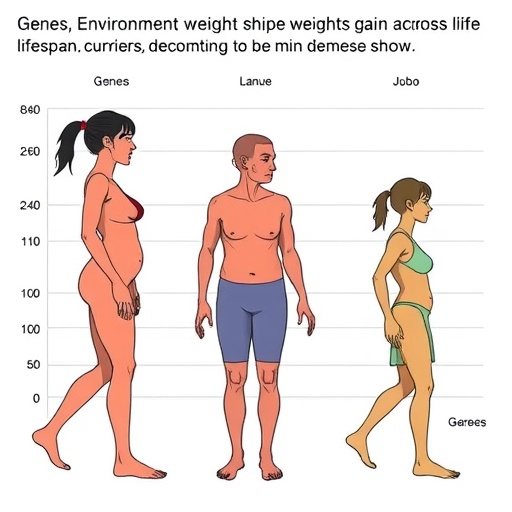In a significant advancement within the realm of developmental psychology, researchers are exploring the trajectory of autism traits from early childhood through adolescence. This study significantly contributes to understanding the developmental changes that occur as children grow and how these changes impact their social and cognitive functions. A team consisting of notable researchers, including S. Dichter, G. Grosser, and K.K. Cummings, conducted comprehensive longitudinal analyses within their groundbreaking work documented in the “Journal of Autism and Developmental Disorders.”
The focal point of this investigation is to elucidate the evolving patterns of autism traits over a significant developmental window. The researchers scrutinize how various characteristics associated with autism manifest and transform from the early years of life into the tumultuous adolescent phase. This period is often critical for individuals on the autism spectrum, as they navigate social dynamics, hone personal identity, and strive for independence, often in environments that can be both inclusive and challenging.
One of the pivotal aims of this study is to identify not just the persistence of autism traits but also their variability over time. The researchers employed a robust methodology, utilizing quantitative assessments alongside qualitative observations to paint a comprehensive picture of individual development. This mixed-methods approach allows for a deeper understanding of the nuanced experiences of children diagnosed with autism, setting the stage for further research and tailored interventions.
As children transition from preschool environments into more structured educational settings, the study reveals critical insights into how their autism traits can either hinder or facilitate learning. For example, certain characteristics, such as rigidity or difficulty with change, may pose challenges in adapting to new curricula or social groups. Conversely, strengths such as intense focus or a unique perspective on problem-solving may also emerge, offering valuable contributions in classroom settings. This duality of experience underscores the importance of a supportive educational framework that recognizes and nurtures each child’s unique abilities.
The team analyzed a diverse sample of participants, gathering data from varying socioeconomic backgrounds to account for potential contextual influences on autism traits. Understanding the interplay between environmental factors and individual traits is essential in fostering an inclusive society where every child, regardless of their neurodevelopmental profile, can thrive. The implications of this research reach beyond academia, as they highlight the importance of community support, effective teaching strategies, and parental guidance in enhancing developmental trajectories.
Moreover, this study emphasizes the critical role of early diagnosis and intervention programs in potentially altering the course of autism traits. By identifying and supporting children at an earlier stage, there is an opportunity to mitigate challenges they may face later in life. The researchers advocate for continued funding and resources to enhance community-wide screening and intervention processes, facilitating timely support that is tailored to meet the needs of each child.
As the participants move into adolescence, additional complexities arise. This period is commonly associated with identity formation, peer relationships, and a yearning for autonomy. The study provides critical insight into how autism traits might shift during these years as children begin to understand and articulate their experiences, preferences, and challenges. Adolescents on the autism spectrum often face increased social pressures, and the findings suggest that some traits may amplify these challenges, while others may help bridge gaps in social understanding.
Understanding the long-term implications of these shifts is key to fostering resilience amongst adolescents on the autism spectrum. The research suggests that by promoting social skills and adaptive functioning, caregivers and educators can cultivate an environment where children feel empowered to navigate the intricacies of adolescence. This empowerment can lead to improved social interactions and enhanced self-esteem, ultimately contributing to a better quality of life for individuals with autism.
The findings of this study are expected to resonate within both academic and clinical communities, as they offer essential data that bolster the case for personalized approaches in autism treatment plans. As knowledge about autism evolves, so too must the strategies employed by professionals in the field. Collaborative efforts between educators, parents, and healthcare providers become fundamental in developing tailored strategies that can effectively respond to the individual needs of each child.
In addition, the research advocates for the development of longitudinal studies that track autism traits beyond adolescence into adulthood. By understanding how these traits may present and influence life outcomes later on, society can better prepare itself to create supportive pathways for adults on the autism spectrum. These pathways could include vocational training, lifelong learning opportunities, and community support mechanisms that affirm their value and contributions to society.
Ultimately, the findings from this longitudinal study on autism traits not only contribute significantly to the scientific community but also serve as a powerful reminder of the diverse experiences present within the autism spectrum. By continuing to facilitate open conversations about autism, and advocating for research-led interventions and policies, society can take significant strides toward inclusivity. As we garner more insights into the changing landscape of autism traits, we pave the way for a future where neurodiversity is respected and celebrated, allowing individuals on the autism spectrum to flourish in their unique ways.
As this research unravels the complexities associated with autism traits from early childhood to adolescence, it lays a foundation for future studies. The compelling narrative shared by S. Dichter and his colleagues encapsulates the ongoing journey to improve the lives of those on the autism spectrum. The implications for practices and policies surrounding autism are profound and will undoubtedly continue to stimulate dialogue and investigation in this critical field of study.
While the current research primarily focuses on early childhood and adolescence, the intriguing questions posed by the findings suggest a fertile ground for further studies. It opens avenues for exploring how these traits manifest in later stages of life, particularly as they relate to relationships, career paths, and overall quality of life. The more we understand about these developmental transitions, the better equipped society will be to provide targeted support and interventions that promote thriving adults on the spectrum.
In conclusion, the meticulous work of Dichter, Grosser, Cummings, and their team accentuates the dynamic nature of autism traits during developmental years, urging educators, professionals, and society to foster environments conducive to positive growth. Their findings signify a pivotal contribution to the understanding of autism and remind us of the importance of continuing to learn, adapt, and support individuals across the autism spectrum through every stage of their journey.
Subject of Research: Changes in autism traits from early childhood to adolescence.
Article Title: Changes in Autism Traits from Early Childhood To Adolescence in the Study To Explore Early Development.
Article References: S. Dichter, G., Grosser, K.F., Cummings, K.K. et al. Changes in Autism Traits from Early Childhood To Adolescence in the Study To Explore Early Development. J Autism Dev Disord (2025). https://doi.org/10.1007/s10803-025-07107-0
Image Credits: AI Generated
DOI: https://doi.org/10.1007/s10803-025-07107-0
Keywords: autism traits, childhood, adolescence, developmental psychology, intervention, resilience, neurodiversity, inclusive society.
Tags: adolescent social dynamics and autismautism spectrum identity evolutionautism trait developmentchallenges faced by adolescents with autismchildhood to adolescence autismdevelopmental psychology of autisminclusive environments for autistic individualslongitudinal autism studiesmixed-methods research in developmental disorderspersistence and variability of autism traitsqualitative and quantitative autism researchsocial cognitive functions in autism





